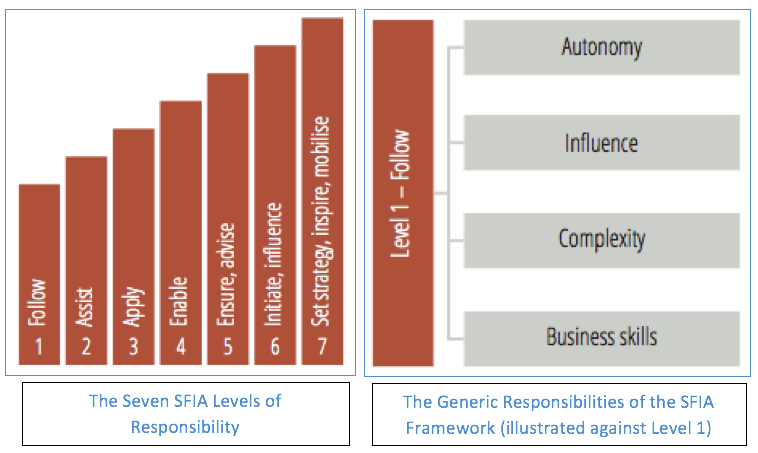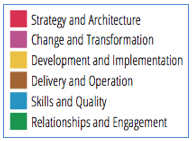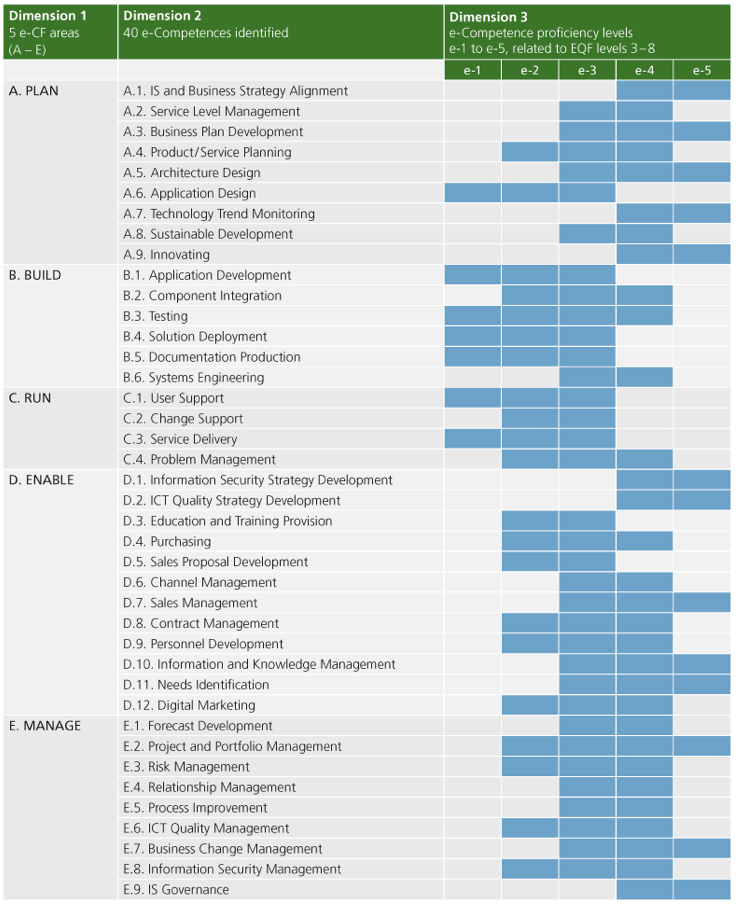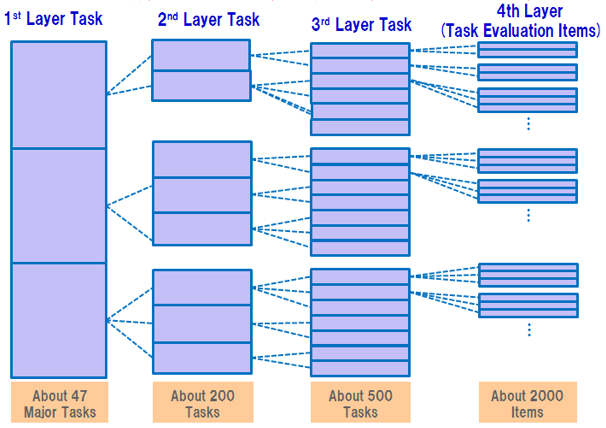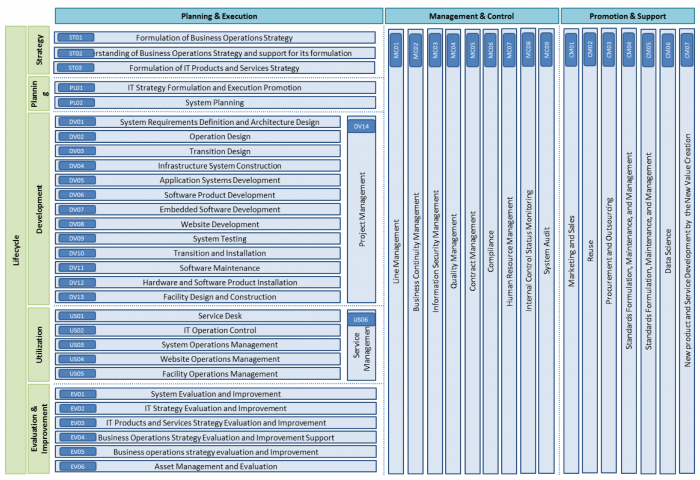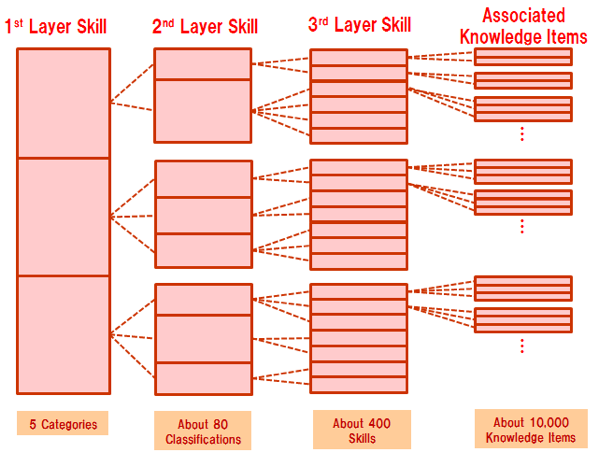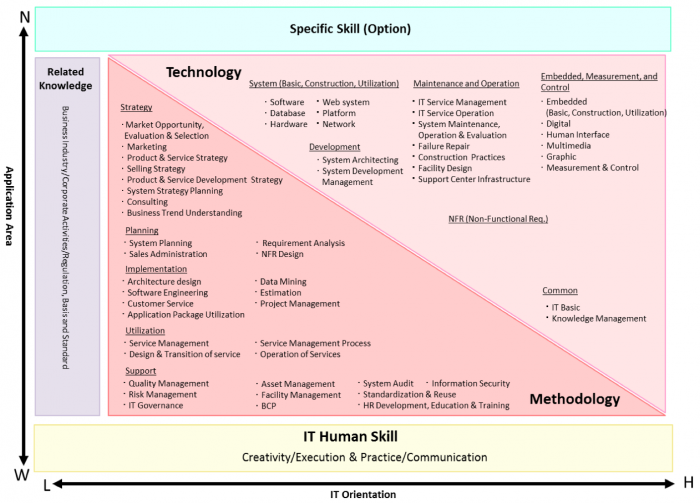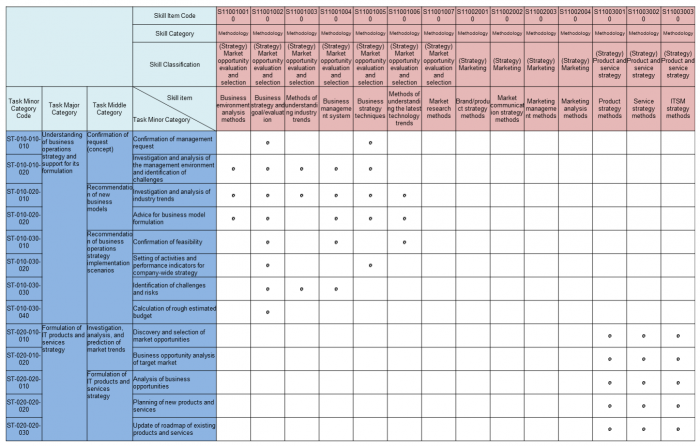Enterprise IT Skill Frameworks
Contents
1 Competency Frameworks
The emphasis on competence has become international as Enterprise IT and ICT in general have become indispensible across the globe. They derive from a growing understanding of the need for a common language for competences, knowledge, skills and proficiency levels that can be understood across national borders. A common framework enables the identification of skills and competences that may be required to successfully perform duties and fulfill responsibilities in an EIT workplace. They provide a common basis for the selection and recruitment of EIT staff, as well as forming the basis for employment agreements, professional development plans, and performance evaluation for ICT professionals.
Many national and regional governments have come to require certification of EIT practitioners. Accordingly, they have had to develop their own definitions of ICT competences. Given the increasingly international composition of the EIT workforce, the EITBOK has included information from 3 major frameworks that are emerging as inter-regional. In general, these frameworks work towards a common understanding of competence, defined by the e-CF, for example, as “demonstrated ability to apply knowledge, skills and attitudes to achieve observable results."
Creating mappings between these frameworks and our chapters is challenging, because they come from different perspectives and have different goals. There is rarely a 100% correspondence between the frameworks and our chapters, and, despite careful consideration some subjectivity was used to create the mappings. Please take that in consideration as you review them.
2 Skills Framework for the Information Age
SFIA has been used for some 26 years and developed using a collaborative approach. The internationally represented SFIA Council oversees the direction of development for the not-for-profit SFIA Foundation, which owns and regularly updates the framework, using a well-established open process, for the benefit of the IT industry and IT professionals. The SFIA Framework has been translated in to 6 languages (English, Spanish, German, Arabic, Japanese and Chinese with more languages scheduled including French and French Canadian). It has been downloaded and used by organizations and individuals in nearly 180 countries. It can be downloaded for free at www.sfia-online.org.
The SFIA Framework identifies 97 professional skills across IT and supporting areas and 7 levels of responsibility. The 7 levels in the SFIA Framework are used to provide generic levels of responsibility and to reflect experience and competency. The SFIA Framework is based on demonstrated ability of applying a skill at a particular level, employing professional and behavioural skills as well as knowledge. The definitions describe the behaviors, values, knowledge and characteristics that an individual should have in order to be considered competent at a particular level. Underlying each SFIA Level are generic responsibilities of Autonomy, Complexity, Influence and Business Skills. These are described at each SFIA Level.
Figure 1. SFIA Levels of Responsibility
The 97 IT skills of the SFIA Framework are grouped into categories and sub-categories, a skill has a name, a code, a skill description and a level description (for that skill at each level practiced).
| Attribute | Description |
|---|---|
| General Responsibilities | The generic responsibility attributes delineated for all skills at all SFIA Levels:
|
| Skill Category | A logical grouping of the skills for the purposes of navigation. These categories are further broken down into sub-categories. |
| Skill Name | The name of the skill |
| Skill Description | A description of what the skill is without reference to the levels practiced |
| Level Descriptors | A description of the skill for each of the levels practiced, phrased to facilitate their use as professional competencies.
|
3 European Competency Framework
The European e-Competence Framework (e-CF) from the European Union provides a reference of 40 competences required for performance in the Information and Communication Technology (ICT) workplace, using a common language for competences, knowledge, skills and proficiency levels that can be understood across Europe. The use of the e-CF by companies and organisations throughout Europe supports the transparency, mobility and efficiency of ICT sector related human resources planning and development.
As the first sector-specific implementation of the European Qualifications Framework (EQF), the e-CF can be used by ICT service, demand and supply organizations, and by managers and HR departments, for education institutions and training bodies, including higher education, by professional associations, trade unions, market analysts and policy makers, and other organisations and parties in public and private sectors. The structure of the framework is based on four dimensions:
| Dimension 1 | 5 e-Competence areas, derived from the ICT business macro-processes PLAN – BUILD – RUN – ENABLE – MANAGE. Main aim of dimension 1 is to facilitate navigation through the framework |
| Dimension 2 | A set of reference e-Competences for each area, with a generic description for each competence. 40 competences identified in total provide the European generic reference definitions of the framework. |
| Dimension 3 | Proficiency levels of each e-Competence provide European reference level specifications on e-Competence levels e-1 to e-5, which are related to EQF levels 3-8. |
| Dimension 4 | Samples of knowledge and skills relate to e-Competences in dimension 2. They are provided to add value and context and are not intended to be exhaustive. |
There are five e-CF proficiency levels, e-1 to e-5, which relate to EQF learning levels 3 to 8. For a description of the EQF levels, please see https://ec.europa.eu/ploteus/en/content/descriptors-page.
| e-Competence Level | EQF Level |
|---|---|
| 5 (highest) | 8 |
| 4 | 7 |
| 3 | 6 |
| 2 | 4 and 5 |
| 1 | 3 |
As in SFIA, not all skills are subject to all 5 levels. The following table shows the spread of competency levels for each skill.
Figure 3. The European Competency Framework Overview
4 The i Competency Dictionary
The i Competency Dictionary (iCD) was developed and is maintained by the Information Technology Promotion Agency (IPA) in Japan. It consists of a comprehensive Task Dictionary and a corresponding Skill Dictionary. The Task Dictionary contains all the tasks that EIT outsourcers or EIT departments are expected to accomplish, while the corresponding Skill Dictionary provides the skills required to perform those tasks.
The diagrams below show how the task and skill dictionaries are structured to be used together. The skills needed to become competent at each task are enumerated in a Task vs. Skill table. In each of the EITBOK chapters, we have shown one of the relevant tasks (at Task layer 2), along with its prerequisite skills from layers 2-4. In the diagrams below, we have indicated the number of tasks and skills that are included in the full iCD. The complete iCD Task Dictionary (Layers 1-4) and Skill Dictionary (Layers 1-4) can be downloaded from the following URL: http://www.ipa.go.jp/english/humandev/icd.html
Note that the IPA is also responsible for the Information Technology Engineers Examination (ITEE), which has grown into one of the largest scale national examinations in Japan, with approximately 600,000 applicants each year.
Figure 4. The iCD Task Dictionary Structure
Figure 5. The iCD Task Dictionalry (1st Layer)
Figure 6. The iCD Skill Dictionary Structure
Figure 7. The iCD Skill Dictionary Structure (1st and 2nd Layer)
Table 8 indicates with a dot in the related cell those skills that are associated with particular tasks. Displayed below is just a small portion of the complete table.
Figure 8. Task Versus Skill Table (extracted)
5 The IEEE Software Engineering Competency Model
The software engineering competency model (SWECOM) describes competencies for software engineers who participate in development of and modifications to software-intensive systems. Skill areas, skills within skill areas, and work activities for each skill are specified. Activities are specified at five levels of increasing competency. Case studies of how the SWECOM model can be used by a manager, an employee, a new hire, or a curriculum designer are provided. Staffing Gap Analysis and Individual Gap Analysis worksheets are included in an appendix.
Individuals may download the SWECOM document here: https://www.computer.org/web/peb/swecom-download
